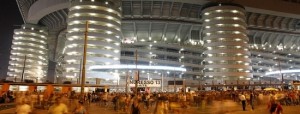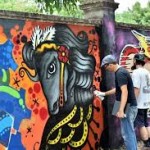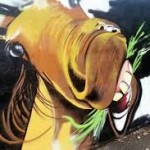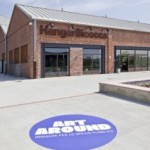Other districts of Milan
THE DISTRICT OF SPORT: SAN SIRO
San Siro is historically the sports center of Milan.
Here are the Stadium and Hippodrome.
STADIUM
The stadium of Milan, takes the name of the neighborhood that houses it, is entitled from 1980 to Giuseppe Meazza, the great Milanese champion between the twenties and forties he played for Inter Milan and AC Milan. It built in 1926, and later expanded, on the occasion of the 1990 World Cup. For this occasion there is provided a real architectural innovation, which consists in the construction of the third ring and the cover through the insertion of eleven autonomous and load-bearing supports.
The stands provide an excellent game viewing and a fine view over the city. Since the seventies, it is also the scene of major concerts that host the most important Italian and international artists.
The gate 14 leads to the San Siro Museum tells the story of the two Milanese teams through cups, shirts, photographs and newspaper pages that accompanied their footballing achievements.
THE RACECOURSE
He is present in this area since 1888 and built by the engineer Giulio Valerio – was created by ‘need to transfer the races that were held in Piazza Andrea Doria and Piazza d’Armi behind the Castello Sforzesco. The current structure dates back to the twenties of the twentieth century and designed by Paolo Vietti-Violi and is divided into areas dedicated to the gallop, characterized by the presence of the green and from the stands in Art Nouveau style, and those at a trot. The riding school, along with Trenno track workout and the stables, is subject to constraint by the Superintendence for Cultural Heritage. In front of the canter secondary grandstand is located since 1999 the great bronze horse, taller than seven meters. It is made in the USA, under the direction of sculptor Nina Akamu, based on drawings by Leonardo da Vinci for the equestrian monument to Francesco Sforza. Definitely worth it to enter at least once in this world and maybe attend one of the races of horse racing.

The stree art lovers will definitely not miss the wall of graffiti. Well worth visiting is the long stretch of the wall that runs along the racecourse gallop on the side of Viale Caprilli and leading to San Siro. It is 1 km of wall granted the Hippodrome. Here every two years to life in an event called “Stadium Street Players”, a stage for street art: 150 artists on the wall 1000m create works of arts.
A wall of graffiti that has as its theme the gallop, where thoroughbreds, jockeys and horse racing scenes seem to come alive with horses resembling men, women, but also machines or psychedelic dreams.
Two years ago the same event had brought many young people armed with cans to perform, leaving the city a lovely cross graffiti themed football, as a legacy of the White Night of San Siro.
BICOCCA DISTRICT
The Bicocca district began as a production area since the beginning of the twentieth century, with the presence of Pirelli industries, operating in the rubber industry and Breda, in the metal and steel industry. Following once cast (as a result of the decentralization of production) we found to manage over 700 thousand square meters of industrial surface areas. Thanks to a project that had as a winner, the study Gregotti Associates, it was possible to give a second life to this district, not leaving him alone a suburban neighborhood.
In fact, thanks to this project, the Bicocca district could have a second life becoming a new neighborhood and a university pole, creating a renovation of the quarter and consolidating the story. The area is defined with large building blocks square traversable inside. The university complex – it houses the University of Milano-Bicocca – forms the core of the project with the large courtyard buildings that house the humanities and science departments. To these are added the Teatro degli Arcimboldi –It inaugurated in January 2002, during the renovation of the Teatro alla Scala as a great space for opera and classical music.
Further north, between the University, is also the Hangar Bicocca, a modern multi-functional structure that hosts events, shows and exhibitions related to the sphere of the visual arts.
Another very important cultural center in this area – in the area of the ex tobacco factory – is the Interactive Museo Interattivo del Cinema, the project of Italian Film Library Foundation and the Lombardy Region.
SUMMARY
1)FASHION DISTRICT AND HISTORICAL CENTER
2)FROM THE MEDIEVAL HEART OF MILAN TO THE CASTLE
3)TICINESE DISTRICT AND NAVIGLI
4)FROM BRERA TO CORSO COMO
5)PORTA NUOVA DISTRICT AND ISOLA DISTRICT
6)CHINATOWN
7)OTHER DISTRICTS: sports district, Bicocca district
8)THE PARKS






